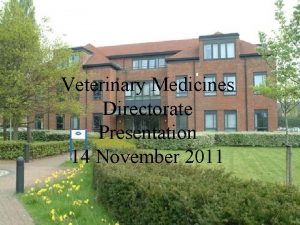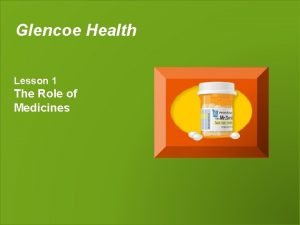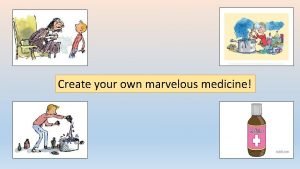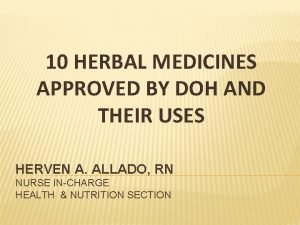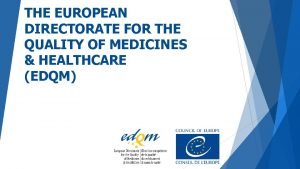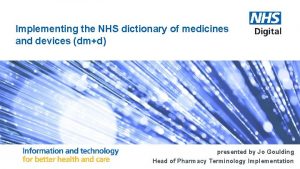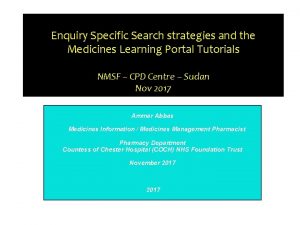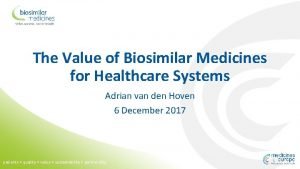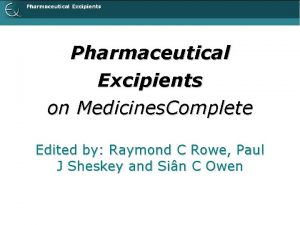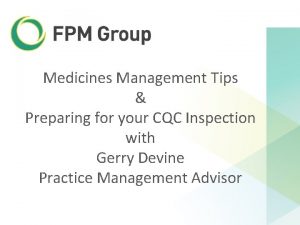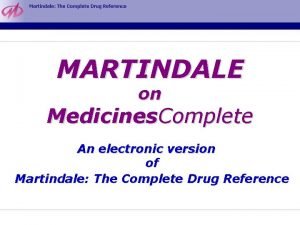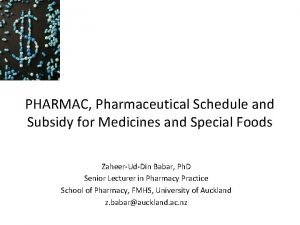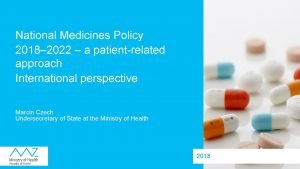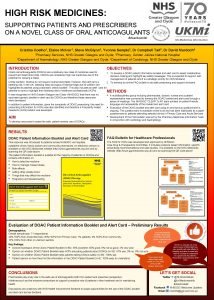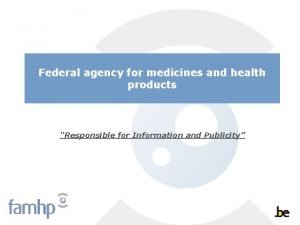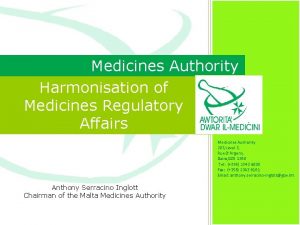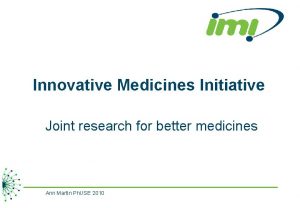Innovative Medicines South Africa IMSA Value of Innovative



































- Slides: 35

Innovative Medicines South Africa (IMSA) Value of Innovative Medicine

Value of Innovative Medicine. Definition of Value “Value is the amount, as of goods, services, or money, considered to be a fair equivalent of something else; a fair price or return. ” The American Heritage® Dictionary of the English Language, Fourth Edition Copyright © 2000 by Houghton Mifflin Company. Published by Houghton Mifflin Company. All rights reserved

What is the Value of Innovative Medicine? Innovative medicines should provide a state of physical, mental and social well -being.

Value of Innovative Medicines “Has a different meaning depending on the Audience” • Patients May Care About – Increased Longevity – Increased Quality of Life • Payers/Employers May Care About – Potential for Direct Offset to Other Health Care Costs – Increased Workplace Productivity

Value of Medicines The Patient Perspective

Innovative Pharmaceuticals Reduce Mortality and Morbidity • Pharmaceuticals (drugs and vaccines) have eliminated or brought under control many diseases and conditions that once had high mortality rates (e. g. , influenza, polio, pneumonia, and diptheria). • Pharmaceuticals have also helped dramatically reduce mortality rates for other diseases and conditions (e. g. , AIDS, asthma, heart attacks, strokes, and ulcers).

New Medicines Have Prolonged Life Drop in Death Rate for Diseases Treated with Pharmaceuticals, 1965– 1995 80% 75% Percent Drop in Death Rate 68% 67% 61% 41% 31% 22% Early Rheumatic Infancy Fever Diseases and Rheumatic Heart Disease Atherosclerosis Hypertensive Ulcer of Heart Stomach and Disease Duodenum Ischemic Heart Disease Emphysema Source: Ph. RMA, Based on Boston Consulting Group, 1993; and US National Center for Health Statistics, 1998 Hypertension

Study Finds Direct Correlation Between Reductions in Mortality and Number of New Drugs for Disease • Over 45 percent of the variation in mortality across diseases between 1970 and 1991 is explained by the extent to which new drugs are used to treat the disease – making new drugs the most important factor in explaining mortality reductions. • Each of the 436 new drugs introduced between 1970 and 1991 annually adds 11, 200 aggregate years of life to the U. S. population. Source: Lichtenberg, Frank, “Pharmaceutical Innovation, Morality Reduction, and Economic Growth, ” Presented at the Conference on the Economic Value of Medical Research, December 1999.

Pharmaceutical Advances Predicted to Continue to Reduce Mortality Rates in Future • Four studies by the Battelle Institute predict disease patterns in 2015 in the U. S. , Germany, France and the United Kingdom. • These studies suggest pharmaceutical innovation will continue to be a major factor in reducing mortality, accounting for: – 19 to 40 percent of the projected reduction in coronary heart disease; – 15 to 40 percent of the reduction in cerebrovascular disease; – 28 to 65 percent of the reduction in breast cancer; and – 3 to 26 percent of the reduction in lung cancer. Source: Hall, M, “The Impact of Behavioral and Biomedical Advance on Health Trends Over the Next 25 Years, ” London, UK: Office of Health Economics; Office of Health Economics Briefing, No. 31, November 1994.

Innovative Health Care is Saving Lives • In 1950, cardiovascular disease claimed four lives out of every 1, 000 annually, today that number has fallen in half. The single most important factor in increasing the lifespan of the average American between 1950 and today is the reduction in cardiovascular disease death. Source: Health, United States 2001, Centers for Disease Control and Prevention, U. S. Department of Health and Human Services, August 2001. Data based on National Vital Statistics System.

Prescription Drugs Save Lives and Money Where were AIDS Drugs Discovered? 122 drugs to treat AIDS HIV Mortality Declined Dramatically After Introduction of First “Expensive” Antiretrovirals. . . First new drugs introduced, 1995 Highly Active Antiretroviral Therapy (HAART) introduced, 1996 -97 …While Monthly Costs for AIDS Patients Decreased by 16% After HAART Introduced Total: $1804 Total: $1521 Other Costs Decrease by 41% Source: Costs - Bozette et al. , New England Journal of Medicine Vol. 344, No. 11, March 15, 2001; Mortality Centers for Disease Control; data on drug development from Ph. RMA and the NIH Office of Technology transfer Drug Costs Increase by 34%

Centenarians in US Population Number Per Million 300 2000 = 262 250 200 150 100 50 1900 = 46 0 1900 1920 1940 1960 1980 Source: Caplow, Theodore, et al. The First Measured Century, Wash DC: AEI, 2001: 9 2000

Cholesterol Fighting Drugs Reduce Risk of Heart Attack or Stroke • Cholesterol-lowering drugs, known as statins, safely reduced the risk of a heart attack or stroke by one-third in the world’s largest study of people at high risk for these conditions. • About 25 million people worldwide take statins today. The new findings suggest that about 200 million people worldwide would benefit from the drugs. • According to the study’s lead investigator, if 10 million high-risk patients started taking statins, 50, 000 deaths would be prevented each year. Source: Lawrence K. Altman, “Cholesterol Fighters Lower Heart Attack Risk, Study Finds, ” The New York Times, November 14, 2001.

New Drugs Improving Quality of Life • Pharmaceuticals help patients improve their quality of life in numerous ways: – Reducing hospitalizations, including emergency room visits – Avoiding surgery – Helping patients remain more active and independent

New Medicines are Reducing Side Effects • • New medicines have been found to reduce side effects, often leading to improved compliance and better health outcomes. For example, gastrointestinal side effects from conventional nonsteroidal anti-inflammatory drugs (NSAIDs) are estimated to be responsible for 107, 000 hospitalizations and 16, 500 deaths annually in the U. S. (Source: “Adverse Upper Gastrointestinal Effects of Rofecoxib Compared with NSAIDs, ” The Journal of the American Medical Association, Vol. 282, No. 20, November 24, 1999. ) • Approximately 20% to 30% of patients who take conventional NSAIDs develop persistent side effects, and more than 10% are estimated to discontinue treatment as a result. (Source: “Anti-Inflammatory and Upper Gastrointestinal Effects of Celecoxib in Rheumatoid Arthritis, ” The Journal of the American Medical Association, Vol. 282, No. 20, November 24, 1999. ) • A new family of NSAIDs known as Cox-2 inhibitors have been proven to cause less stomach irritation and carry a lower risk of complications than conventional NSAIDs.

Value of Medicines The Employer/Payer Perspective

Greater Use of Pharmaceuticals is Leading to Declines in Hospital Admissions, Lengths-of-Stay, and Surgical Procedures • Hospital admissions, length-of-stay, and surgical procedures declined most rapidly for those diagnoses with the greatest increase in the total number of drugs prescribed and the greatest change in the distribution of drugs. • The estimates imply that an increase of 100 prescriptions is associated with 16. 3 fewer hospital stays. Source: Frank R. Lichtenberg, “Do (More and Better) Drugs Keep People Out of Hospitals? ” The American Economic Review, Papers and Proceedings of the Hundredth and Eighth Annual Meeting of the American Economic Association, May 1996.

Prescription Medicines May Help Avert Asthma-Related Hospitalization and Emergency Room Visits • Treatment of allergic rhinitis may keep patients out of the hospital and away from emergency rooms according to a recent study. • The study, using claims data from 4, 944 privately-insured patients diagnosed with both allergic rhinitis and asthma, found that patients treated with nasal inhaled steroids, sedating antihistamines, and/or non-sedating antihistamines were about half as likely to have an asthma-related event (hospitalization or emergency room visit) than those not treated. Source: Jodi Crystal-Peters, et al. , “Treating Allergic Rhinitis in Patients with Comorbid Asthma: The Risk of Asthma-Related Hospitalizations and Emergency Department Visits, ” J Allergy Clin Immunology 109 (January 2002) 1: 57 -62.

Disease Management & Free Access to Diabetes Medicines Lowers Employee Medical Costs Total Medical Costs for Employees Diagnosed with Diabetes, City of Asheville, NC (USA) 1996 - 2001 Source: John Miall, City of Asheville

New Drugs Particularly Cost Effective Relative to the Products They Replace Illustration of Estimated Savings from Use of Newer Medications (assumes average “age” of drug decreases by about 10 years) Drug Cost Increase Inpatient Savings Office Visit Savings Home Health Savings Outpatient Savings ER Savings Net Impact: $18 Investment Returns $129 in Savings Ratio of $7 Saved for Every $1 Invested Source: Professor Frank Lichtenberg, “Benefits and Costs of Newer Drugs: An Update, ”NBER Working Paper 8996, June 2002

New Drugs Increasing Worker Productivity • For employers, the value of pharmaceuticals is reflected in increased worker productivity, reduced absenteeism, and overall improvements in workforce health. • Researchers at MIT studied pre- and post-treatment work records for employees with four conditions to determine the number of hours worked in a two-week period. • Employees receiving treatment with pharmaceuticals were able to significantly increase the number of hours worked.

Medicines Provide ROI to Employers Through Improved Workforce Productivity Source: National Committee for Quality Assurance, Quality Dividend Calculator, 2001; http: //www. ncqacalculator. com/Ncqa/Index. asp

Source: Berndt, et al. , “Illness and Productivity: Objective Workplace Evidence, ” Working Paper #42 -97, Massachusetts Institute of Technology (MIT), May 1997.

Are Advances in Medicine Worth the Cost? Change in Treatment Cost Increase in Value Source: Cutler & Mc. Clellan, Health Affairs, Sept/Oct 2001

Drugs are one Component of a Comprehensive approach to the Cost of Treating Disease Direct Costs Indirect Costs • • • Decreased Productivity • Absenteeism • Caregiver Issues Drugs Provider Hospital Nursing Home Other Are all these cost factors taken into consideration when treatment is decided on for the patient?

New Drug Development

New Product Development - A Risky and Expensive Proposition Compound Success Rates by Stage Years Discovery (2– 10 Years) 0 2 4 Preclinical Testing Laboratory and Animal Testing 6 Phase I 20– 80 Healthy Volunteers Used to Determine Safety and Dosage Phase III 1, 000– 5, 000 Patient Volunteers Used to Monitor Adverse Reactions to Long-term Use 10 Additional Post-marketing Testing 16 8 Phase II 100– 300 Patient Volunteers Used to Look for Efficacy and Side Effects 12 14 Regulatory Approval 5, 000– 10, 000 Screened 250 Enter Preclinical Testing 5 Enter Clinical Testing 1 Approved by the FDA Net Cost: $802 million invested over 15 years Source: Tufts Center for the Study of Drug Development

The Cost of Drug Development Continues to Increase Nominal Dollars (Millions) Average Capitalized Development Cost per NCE, 1976 -2001 Sources: R. Hansen, Ph. D. , University of Rochester; S. N. Wiggins, Ph. D. , Texas A&M University; J. A. Di. Masi, Tufts Center for the Study of Drug Development (2002); Office of Technology Assessment (1993)

So-Called “Me-Too” Drugs Create a Highly Competitive Marketplace Year of Therapeutic Class Launch 1965 1975 1985 1995 Shrinking Time Without Competition Source: FDA Orange Book

Private Industry - Invents the Vast Majority of New Medicines Where Did All New Drugs Approved from 1990 -1999 Come From? Where Did AIDS Drugs Come From? Source: Di. Masi, Hansen, and Grabowski, Tufts CSDD R&D Cost Study, 2002 (overall data); Data on AIDS drug development from Ph. RMA and the NIH Office of Technology transfer

Investments in New Drug Development • Public sector cannot afford the huge investments needed for new product development. • The world still needs new drugs for treatment of ailments such as HIV/AIDS, Cancer, TB and Malaria. • The incentive to invest in new product development should be maintained and nurtured.

Major Degenerative Diseases Number of Deaths Per 100, 000 Population Per Year 600 Major Cardiovascular Diseases (Heart Disease, Stroke, High Blood Pressure) 1972=352 400 1900=345 200 1972=201 Cancer 1900=64 0 1900 1920 1940 1960 1980 Source: Caplow, Theodore, et al. The First Measured Century, Wash DC: ADI, 2001: 137 2000

Intellectual Property • Protection of intellectual Property provides an incentive for investing in new drug development. • The period of exclusivity provided by a patent: Ø Allows innovators to recoup their investment costs. Ø Achieve a reasonable return. Ø Allows for more money to be invested in future drug development.

Intellectual Property Failure to protect/enforce Intellectual Property will lead to the following: Ø Less incentive to invest in new drug development resulting in no hope for cure and treatment of high burden diseases such as HIV/AIDS, Cancer, Malaria and TB. Ø Counterfeits leading to severe exposure to untested, unsafe and ineffective medicines

Summary - A Few Key Points • Treatment cost is rising! – That’s good! Because as demonstrated, overall health care costs can potentially be reduced • Prescription drugs are not the key cost drivers in health care • Health care is a Dynamic Good – Patients and Society Have Reaped Exceptional Returns from Medical Innovation and have an Enormous Stake in its Continued Progress • New drug development is a very risky business • The Challenge of the Future – Maintain/Enhance Progress Against Illness – Provide Incentives for Innovation of medicine
 Moodle imsa
Moodle imsa Value creation value delivery value capture
Value creation value delivery value capture Veterinary medicines directorate
Veterinary medicines directorate Chapter 19 lesson 1 the role of medicines worksheet answers
Chapter 19 lesson 1 the role of medicines worksheet answers Staff of marvelous medicines
Staff of marvelous medicines Refrigerant management program
Refrigerant management program Ward controlled system
Ward controlled system Niyog niyogan health benefits
Niyog niyogan health benefits European directorate for the quality of medicines
European directorate for the quality of medicines What was significant about the way the 1902 coal strike
What was significant about the way the 1902 coal strike Nhs dictionary of medicines and devices
Nhs dictionary of medicines and devices Medicines learning portal
Medicines learning portal Ectoparasiticides veterinary medicines
Ectoparasiticides veterinary medicines European medicines agency
European medicines agency Medicines complete
Medicines complete Cqc medicines management
Cqc medicines management Medicines information centre
Medicines information centre Medicines complete
Medicines complete Pharmac schedule
Pharmac schedule National medicines policy
National medicines policy Ggc medicines
Ggc medicines Federal agency for medicines and health products
Federal agency for medicines and health products Agrement south africa
Agrement south africa Herbalife levels and income
Herbalife levels and income South africa unemployment rate by race
South africa unemployment rate by race Naki naki getto
Naki naki getto Doctrine of unjust enrichment
Doctrine of unjust enrichment Southwest asia
Southwest asia 11 official languages of south africa
11 official languages of south africa Musket
Musket How many capital cities in south africa
How many capital cities in south africa Antenatal assessment format
Antenatal assessment format Oxford university press south africa
Oxford university press south africa 6 ministerial priorities of health
6 ministerial priorities of health Naairs south africa
Naairs south africa Ibm client center
Ibm client center


